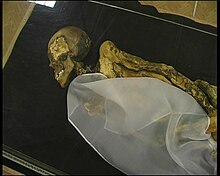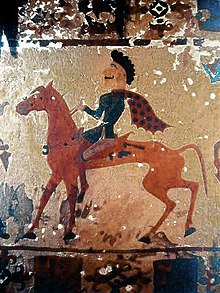Pazyryk level
| Prehistoric cultures of Russia | |
| Mesolithic | |
| Kunda culture | 7400-6000 BC Chr. |
| Neolithic | |
| Bug Dniester culture | 6500-5000 BC Chr. |
| Dnepr-Don culture | 5000-4000 BC Chr. |
| Sredny Stog culture | 4500-3500 BC Chr. |
| Ekaterininka culture | 4300-3700 BC Chr. |
| Fatyanovo culture | around 2500 BC Chr. |
| Copper Age | |
| North Caspian culture | |
| Spa culture | 5000-3000 BC Chr. |
| Samara culture | around 5000 BC Chr. |
| Chwalynsk culture | 5000-4500 BC Chr. |
| Botai culture | 3700-3100 BC Chr. |
| Yamnaya culture | 3600-2300 BC Chr. |
| Afanassjewo culture | 3500-2500 BC Chr. |
| Usatovo culture | 3300-3200 BC Chr. |
| Glaskovo culture | 3200-2400 BC Chr. |
| Bronze age | |
| Poltavka culture | 2700-2100 BC Chr. |
| Potapovka culture | 2500-2000 BC Chr. |
| Catacomb tomb culture | 2500-2000 BC Chr. |
| Abashevo culture | 2500-1800 BC Chr. |
| Sintashta culture | 2100-1800 BC Chr. |
| Okunew culture | around 2000 BC Chr. |
| Samus culture | around 2000 BC Chr. |
| Andronovo culture | 2000-1200 BC Chr. |
| Susgun culture | around 1700 BC Chr. |
| Srubna culture | 1600-1200 BC Chr. |
| Colchis culture | 1700-600 BC Chr. |
| Begasy Dandybai culture | around 1300 BC Chr. |
| Karassuk culture | around 1200 BC Chr. |
| Ust-mil culture | around 1200–500 BC Chr. |
| Koban culture | 1200-400 BC Chr. |
| Irmen culture | 1200-400 BC Chr. |
| Late corporate culture | around 1000 BC Chr. |
| Plate burial culture | around 1300–300 BC Chr. |
| Aldy Bel culture | 900-700 BC Chr. |
| Iron age | |
| Baitowo culture | |
| Tagar culture | 900-300 BC Chr. |
| Nosilowo group | 900-600 BC Chr. |
| Ananino culture | 800-300 BC Chr. |
| Tasmola culture | 700-300 BC Chr. |
| Gorokhovo culture | 600-200 BC Chr. |
| Sagly bashi culture | 500-300 BC Chr. |
| Jessik Beschsatyr culture | 500-300 BC Chr. |
| Pazyryk level | 500-300 BC Chr. |
| Sargat culture | 500 BC Chr. – 400 AD |
| Kulaika culture | 400 BC Chr. – 400 AD |
| Tes level | 300 BC Chr. – 100 AD |
| Shurmak culture | 200 BC Chr. – 200 AD |
| Tashtyk culture | 100–600 AD |
| Chernyakhov culture | AD 200–500 |

The Pasyryk stage was the younger stage of the Scythian culture in the Altai . It followed the Majemir stage and, thanks to radiocarbon dating and dendrochronology, can be classified in the 5th – 3rd centuries . Century BC To date.
Finds
Among the legacies of the Pasyryk stage stand out some large kurgan , whose burial chambers were preserved in the permafrost , whereby they provide unique conclusions about the culture of the Central Asian equestrian nomad cultures of the Iron Age . A number of such necropolises are known, including the eponymous necropolis of Pasyryk , Baschadar, Tujekta, Ulandryk, Polosmak and Berel. The kurgan were excavated in 1947 by Sergei Ivanovich Rudenko .
All of the great Kurgane show a very similar structure: they had a stone embankment with a diameter of up to 50 meters; underneath there was a burial chamber built in block construction at a depth of up to seven meters. The deceased's entrails were removed, then his body was embalmed and buried in a tree coffin on the south wall of the burial chamber. The often robbed chambers contained a multitude of accessories: furniture, clay pots, bags, carpets and even musical instruments. Among these additions, the 189 × 200 cm so-called Pasyryk carpet from Kurgan 5, which is considered the oldest preserved knotted carpet, is particularly well known. The Pasyryk harp from Kurgan 2 provides the oldest evidence of an angular harp in northern Asia. Several splendidly decorated horses were buried north of the burial chambers.
In the art of the Pasyryk level, known exclusively from the Kurgan, the Scythian animal style plays an important role, whereby the griffin is often represented in addition to the horse ; there is also a large number of geometric motifs. Settlements or camp sites are so far unknown, the bearers of the Pasyryk culture were presumably horsemen . The dead are mostly of the " European " type. They are often called "Altai Scythians" in archaeological research because their culture is reminiscent of that of the Scythians and Sarmatians . However, due to a lack of written records, they cannot be classified with certainty in terms of ethnicity or linguistics.
literature
- H.-P. Francfort, G. Ligabue, Z. Samashev: Découverte d'une tombe princière gelée d'époque scythe à Berel 'dans l'Altai (Kazakhstan oriental). In: Académie des Inscriptions et Belles-Lettres, Comptes rendus 1998 , pp. 1165-1175
- MP Grjasnow: Altai i prialtaiskaja step. In: MG Moschkowa (ed.): Stepnaja polosa Asiatskoi tschasti SSSR w skifo-sarmatskoe wremja. Archeologija SSSR. Moscow 1992
- Hermann Parzinger : The early peoples of Eurasia. From the Neolithic to the Middle Ages. Historical Library of the Gerda Henkel Foundation, Volume 1. Beck, Munich 2006 ISBN 978-3-406-54961-8 , pp. 588 ff. Fig. 194–198.
- NV Polosmak, Martina Seifert : People from the ice of Siberia. Newly discovered barrows (Kurgane) in the permafrost of the Altai. In: Antike Welt 27, 1996, pp. 87-108
- SI Rudenko: Kultura naselenija Gornogo Altaja w skifskoje wremja. Moscow / Leningrad 1953
- SI Rudenko: The second Kurgan of Pasyryk. Publishing house for culture and progress, Berlin 1951
Individual evidence
- ↑ The dates in the table are taken from the individual articles and do not always have to be reliable. Cultures in areas of other former Soviet republics were included.
- ^ Parzinger 2006


